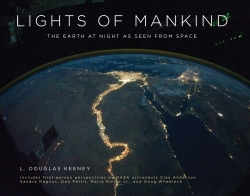Lights of Mankind
The Earth at Night as Seen From Space
Humans have always been fascinated with looking at themselves. They pass down myths about the dangers of trying to kiss one’s own reflection. They use self-recognition to test interspecies intelligence. And 17,300 years after the first Paleolithic painter immortalized a fellow hunter on a cave wall in Lascaux, France, patrons still flock to art galleries to purchase new portrayals of themselves and their society.
With the dawn of space exploration, humanity encountered a new perspective. From space, the planet appeared smaller and the greatest of humanity’s creations, larger. Hundreds of miles above Earth’s surface, petty issues of individuality disappear to reveal the complex grandeur of civilization. Containing 287 astronaut photographs and composite images, L. Douglas Keeney’s newest book, Lights of Mankind: The Earth at Night as Seen from Space, turns this macro view into something beautiful and informative.
For Keeney, cofounder of the Military Channel (owned by Discovery Communications) and author of ten books on military history, Lights of Mankind represents a departure from his usual arena. He brings to this collection not only a sense of wonder at what humans have created but also a historian’s understanding of why and how.
With each series of photographs, Keeney highlights important chapters of the human story, from the role of agriculture along the Nile that became the cobra-like line of lights seen today from space to the levees shaping New Orleans. Due to the brevity of his observations and the large format of the night-sky photographs, viewers can appreciate what they see without being overwhelmed. Along with his own notes, Keeney also includes a series of first-hand accounts from the astronauts themselves. These essays offer a look at the technology used to make photography possible from the International Space Station, as well as the sense of wonder one feels 220 miles above home.
At the beginning of each geographic region that forms the various sections of the book, an Earth at Night image from NASA offers readers a global context before diving down into the pages of metropolitan constellations. Taken at an altitude of 22,000 miles and then enhanced by visual artists at the Goddard Space Flight Center, the compositions separate dark oceans from otherwise indistinguishable dark land masses. Additionally, the lighted areas of these images have been adjusted to more accurately represent the relative degree of urbanization shown.
Near the end of the Lights of Mankind, Keeney takes a different look at the lights humans use at night. Like the ancient astronomers, he finds pictures unintentionally created by the lighted cities. Mythical birds, carnivorous plants, and other fanciful images take shape with only a little imagination. Even when looking at itself, humanity reflects the beauty of the stars and cosmos that surround it. “And if you look past the Earth into the blackness of space,” writes astronaut Mario Runco Jr. in one essay, “you are confronted with the reality of infinity. It is an amazing confluence of science, art, history, philosophy, and religion.”
He’s right. For those of us who can’t make it into space to look past Earth, there’s now Lights of Mankind.
Reviewed by
Joseph Thompson
Disclosure: This article is not an endorsement, but a review. The publisher of this book provided free copies of the book and paid a small fee to have their book reviewed by a professional reviewer. Foreword Reviews and Clarion Reviews make no guarantee that the publisher will receive a positive review. Foreword Magazine, Inc. is disclosing this in accordance with the Federal Trade Commission’s 16 CFR, Part 255.

